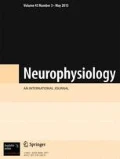Abstract
We studied emotional stress-induced modulations of the pain reaction evoked in mice of strains C57BL/6J and CBA/CaLac by subcutaneous injections of formalin; the measurements were performed at midtimes of a “dark” and a “light” phase of the pre-set fixed circadian rhythm. The magnitude of the pain reaction was estimated indirectly, according to characteristics of locomotion of the animal in a running wheel (the velocity of locomotion and the distance covered were considered values inversely correlating with the intensity of the pain response). We found that the intensity of the pain reaction within both phases of the circadian rhythm increased under the influence of stress, and that there were significant differences between the emotional stress-modulated intensities of the pain response observed in the examined genetic strains of mice.
Similar content being viewed by others
References
A. V. Kaluev, Problems of Studies of Stress-Related Behavior [in Russian], CSF, Kyiv (1999).
H. Imbe, Y. Iwai-Liao, and E. Senba, “Stress-induced hyperalgesia: animal models and putative mechanisms,” Front. Biosci., 11, 2179–2192 (2006).
D. A. Golombec, E. Escolar, L. J. Burin, et al., “Time-dependent melatonin analgesia in mice: inhibition by opiate or benzodiazepine antagonist,” Eur. J. Pharmacol., 194, No. 1, 25–30 (1991).
I. A. Arshavskii, Physiological Mechanisms and Regularities of Individual Development [in Russian], Nauka, Moscow (1982).
Z. K. Blandova, V. A. Doushkin, and A. M. Malashenko, Strains of Laboratory Animals Used in Medical/Biological Studies [in Russian], Nauka, Moscow (1983).
A. J. Greenshaw, T. V. Nguyen, and D. J. Sander, “Animal models for assessing anxiolytic, neuroleptic, and antidepressant drug action,” Neuromethods, 10, 379–427 (1988).
J. Bureš, O. Burešova, and J. Hewstone, Techniques and Basic Experiments for Studying the Brain and Behavior [Russian translation], Nauka, Moscow (1991).
M. F. Jett and S. Michelson, “The formalin test in rat: validation of an automated system,” Pain, 64, No. 1, 19–25 (1996).
D. Jourdan, D. Ardid, L. Bardin, et al., “A new automated method of pain scoring in the formalin test in rats,” Pain, 71, No. 3, 265–270 (1997).
B. S. Sushko, “Peculiarities of the pain reaction and sensitivity in animals of different genetic groups,” Fiziol. Zh., 50, No. 2, 75–79 (2004).
M. Ebadi, P. Govitrapong, P. Phansuwan-Pujito, et al., “Pineal opioid receptors and analgesic action of melatonin,” J. Pineal Res., 24, 193–200 (1998).
R. D. Porsolt, R. A. McArthur, and A. Lenegre, “Psychotropic screening producers,” in: Methods in Behavioral Pharmacology, F. Van Haaren (ed.), Academic Press, New York (1993), pp. 23–51.
Author information
Authors and Affiliations
Corresponding authors
Additional information
Neirofiziologiya/Neurophysiology, Vol. 38, Nos. 5/6, pp. 466–471, September–December, 2006.
Rights and permissions
About this article
Cite this article
Budak, A.V., Sushko, B.S. Hyperalgesic effect of emotional stress in mice of strains C57BL/6J and CBA/CaLac: Interaction with circadian rhythm-related effects. Neurophysiology 38, 396–401 (2006). https://doi.org/10.1007/s11062-006-0077-z
Received:
Issue Date:
DOI: https://doi.org/10.1007/s11062-006-0077-z


